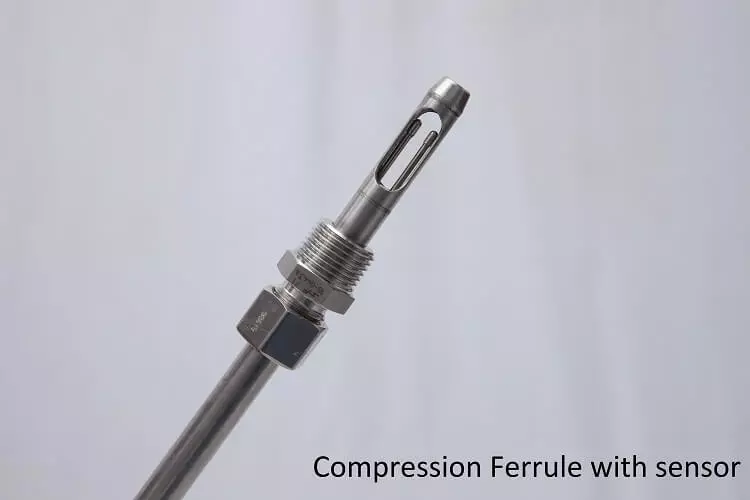LEOMI-586 THERMAL FLOW SENSOR OR THIN-FILM FLOW SENSOR TECHNOLOGIES?? CHOOSE WISELY!
There are various types of thermal flow velocity sensors available in markets based on proprietary designs concerning application requirements and customer price expectations.
The thermal mass flow meter sensor uses RTD Pt-100 elements for measuring flow velocity.
Mainly two types of RTD Pt-100 elements are used to produce thermal flow sensor:
- The platinum wire of a ceramic wire-wound RTD Pt100 sensor is wound into a small coil that is inserted into the holes of a high purity alumina tube. The ODs of these high purity alumina tube varies from 0.8 mm to 4.5 mm, so they are even suitable for the thinnest RTD mineral insulated cables. It is quite expensive than thin-film resistors.
- Thin-film RTDs are platinum elements that are constructed by placing a sensing platinum layer over a ceramic substrate, covered with passivation glass layers. This results in excellent shock and vibration resistance and protects the Pt sensor element from environmental influences. It is quite cheaper than ceramic wire wound resistors.
Leomi-586 uses a ceramic wire wound RTD Pt-100 sensor with a specialized encapsulation process for the best performance for almost every type of application.
Customer’s process conditions determine which type of thermal flow sensor is better for the application as each has its pros and cons.
LEOMI-586 FLOW SENSOR ADVANTAGES USING CERAMIC WIRE-WOUND RESISTORS
- High accuracy better than ±1.5% of reading of along the entire temperature range
- High dynamic range & resolution
- Wide temperature ranges -40°C to 500°C
- Designed with lead length compensation
- High powered & high differential temperature ranges possible
- Rugged & drift-free
- Unaffected by moisture, dirt
LEOMI-586 FLOW SENSOR DISADVANTAGES USING WIRE-WOUND RESISTORS
- Larger footprint in length up to 25mm
- Highly expensive than flow sensor made from thin-film resistors
THERMAL FLOW SENSOR ADVANTAGES USING THIN-FILM RESISTORS
- Compact size (around 3mm, or 1/8-inch) in length
- Vibration resistance due to smaller mass and size
- Tip-sensitive sensor construction
- Cheaper than a ceramic wire-wound flow sensor
THERMAL FLOW SENSOR DISADVANTAGES USING THIN-FILM RESISTORS:
- Loss of accuracy ±3% of reading at low and high temperatures
- Works up to 60°C temperatures
- Low power and low differential temperature range
- Lower dynamic range & resolutions
- High drift due to moisture, dirt, and dust
- No lead length compensation
FIND HERE, WHY YOU SHOULD CHOOSE LEOMI-586 OVER OTHER THIN FILM FLOW TECHNOLOGIES???
LEOMI to serve various process industries rugged application developed various types of thermal flow sensors in SS-316Ti, Haste alloy C276, HALAR® coated, PFA coated construction to meets challenging demands. It has robust construction & a rugged flow-sensor design with Pt-100 RTD ceramic wire-wound sensor which provides stable output non-drift, vibration resistant encapsulation, and mechanically strong than thin-film flow sensor.
Leomi with proven design from (formerly SF-586b) Leomi-586 Insertion Thermal mass flow meter utilizes a combination of an analog controller for high resolution & quick action and digital controller for very high absolute accuracy and long-term stability against the disadvantages of a wheat stone bridge.

LEOMI 586 thermal mass flow sensor with all above merits a preferred choice for any simple or rugged application with accurate, repeatable & stable than thin-film flow sensor. LEOMI provides sensors that can be easily operated even in corrosive gases with HALAR®& PFA coatings upon requests.
For any queries drop us an email will be happy to assist you.
From simple airflow velocity transmitter at room conditions needs economical design which uses thin-film resistors whereas application such as hot air or flue gas demands for rugged flow velocity sensor design which has many other technical considerations of high temperature, corrosion, dirt, moisture, dust to be taken into account for performance.
Thin film-based flow sensors are used bare & un-capsulated whereas Leomi-586 flow sensor used for harsh process gases used with various metallic encapsulated for their long term performance.
Economical thin-film flow sensors are mainly used for ventilation air, compressed air which is low powered sensor generally flow velocity measurement is done with wheat stone bridge circuitry arrangement which is prone to electrical drifting, no lead length compensation, difficult adjustment of sensors apart from this corrosion due to moisture, sensor drift due to dirt, mechanical vulnerability and many more. So, it ultimately affects the stability, accuracy & life of the flow sensor.




